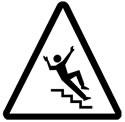 Places of business, residences, parking and recreational areas contain potential accident sources such as slippery floors and stairs, product displays, automatic doors, ledges, railings, elevators, escalators and other hazardous items. To prevent such items from causing injury to the public, premises owners and their agents have a responsibility to recognize unsafe conditions and exercise reasonable care to maintain or make conditions safe, or warn the public of the risks involved. One way this can be accomplished is by maintaining regularly scheduled inspections to check for unsafe conditions and correcting or warning against identified hazards before accidents occur.
Places of business, residences, parking and recreational areas contain potential accident sources such as slippery floors and stairs, product displays, automatic doors, ledges, railings, elevators, escalators and other hazardous items. To prevent such items from causing injury to the public, premises owners and their agents have a responsibility to recognize unsafe conditions and exercise reasonable care to maintain or make conditions safe, or warn the public of the risks involved. One way this can be accomplished is by maintaining regularly scheduled inspections to check for unsafe conditions and correcting or warning against identified hazards before accidents occur.
Expertise
We have extensive experience in many aspects of premises accidents including:
- Membership in Human Factors & Ergonomics Society
- Building codes and safety standards
- Step, curb and parking lot lighting requirements
- Elevator maintenance
- Guardrail heights
Questions Answered
Through scientific analysis, we can help you answer pertinent questions such as:
- How slippery was the floor?
- Did the elevator's rapid decent cause the occupant's injuries?
- Were there proper warnings in place?
- Was sufficient lighting provided?
- Did the staircase where a person fell meet building code requirements?
Case Examples
Exterior Staircase Fall Down:
After exiting a public building, an elderly woman descended an outdoor, wide set of stairs. While doing so, she lost her balance, fell, and was seriously injured. Upon inspection, we determined that the rise height of the step where she fell was a half-inch higher than the previous steps. In addition, there was no handrail nearby. Both these items represented significant hazards and building code violations. The defendant settled the lawsuit after receiving a copy of our report.
Falling Lumber Display:
A carpenter was purchasing a 1" x 5" x 10' plank from a large home improvement store. The lumber was displayed in self-service bins. During the selection process, a 12' plank slid off from an adjacent bin and struck the carpenter, injuring him. After we demonstrated that the lumber display was perfectly safe and could only have been in an unsafe position as a result of the carpenter's or a recent prior customer's actions, the case was settled.
Kristopher J. Seluga, PE, is a Mechanical Engineering, Accident Reconstruction, Biomechanics, and Safety Expert with over 20 years of experience. He received his Bachelor's and Master's degrees from the Mechanical Engineering department at MIT where he worked on the development of novel three-dimensional printing technologies. Mr. Seluga is also a licensed Professional Engineer in New York and Connecticut, and has served as a member of the ANSI engineering committee for the Z130.1 and Z135 standards for golf cars and PTV's. His research interests and peer reviewed publications span the topics of Motor Vehicle Dynamics, Product Safety, and Biomechanics.
©Copyright - All Rights Reserved
DO NOT REPRODUCE WITHOUT WRITTEN PERMISSION BY AUTHOR.



 Places of business, residences, parking and recreational areas contain potential accident sources such as slippery floors and stairs, product displays, automatic doors, ledges, railings, elevators, escalators and other hazardous items. To prevent such items from causing injury to the public, premises owners and their agents have a responsibility to recognize unsafe conditions and exercise reasonable care to maintain or make conditions safe, or warn the public of the risks involved. One way this can be accomplished is by maintaining regularly scheduled inspections to check for unsafe conditions and correcting or warning against identified hazards before accidents occur.
Places of business, residences, parking and recreational areas contain potential accident sources such as slippery floors and stairs, product displays, automatic doors, ledges, railings, elevators, escalators and other hazardous items. To prevent such items from causing injury to the public, premises owners and their agents have a responsibility to recognize unsafe conditions and exercise reasonable care to maintain or make conditions safe, or warn the public of the risks involved. One way this can be accomplished is by maintaining regularly scheduled inspections to check for unsafe conditions and correcting or warning against identified hazards before accidents occur.






